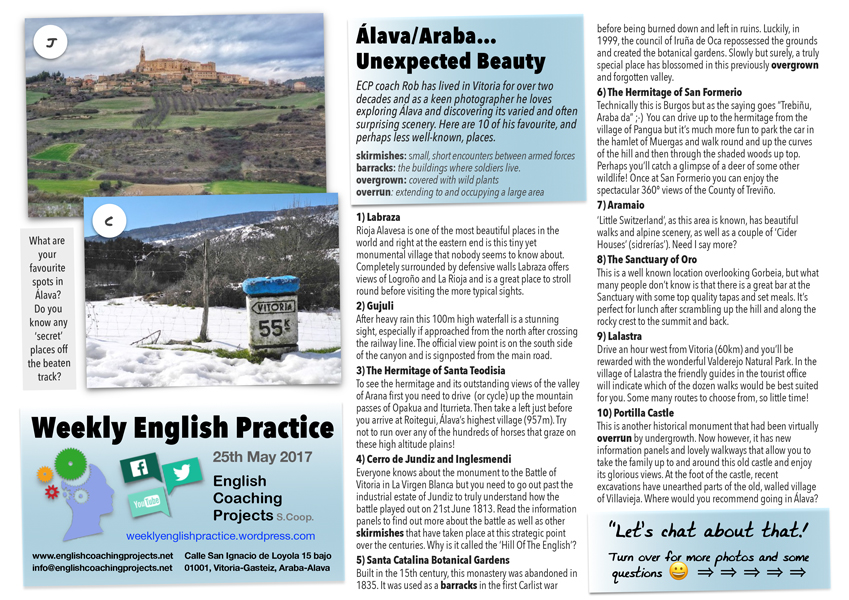Click on the image to download the pdf
ECP coach Rob has lived in Vitoria for over two decades and as a keen photographer he loves exploring Álava and discovering its varied and often surprising scenery. Here are 10 of his favourite, and perhaps less well-known, places.
Vocabulary. Read and check you understand this before you read and listen to the article:
skirmishes: small, short encounters between armed forces
barracks: the buildings where soldiers live.
overgrown: covered with wild plants
overrun: extending to and occupying a large area
1) Labraza
Rioja Alavesa is one of the most beautiful places in the world and right at the eastern end is this tiny yet monumental village that nobody seems to know about. Completely surrounded by defensive walls Labraza offers views of Logroño and La Rioja and is a great place to stroll round before visiting the more typical sights.
2) Gujuli
After heavy rain this 100m high waterfall is a stunning sight, especially if approached from the north after crossing the railway line. The official view point is on the south side of the canyon and is signposted from the main road.
3) The Hermitage of Santa Teodisia
To see the hermitage and its outstanding views of the valley of Arana first you need to drive (or cycle) up the mountain passes of Opakua and Iturrieta. Then take a left just before you arrive at Roitegui, Álava’s highest village (957m). Try not to run over any of the hundreds of horses that graze on these high altitude plains!
4) Cerro de Jundiz and Inglesmendi
Everyone knows about the monument to the Battle of Vitoria in La Virgen Blanca but you need to go out past the industrial estate of Jundiz to truly understand how the battle played out on 21st June 1813. Read the information panels to find out more about the battle as well as other skirmishes that have taken place at this strategic point over the centuries. Why is it called the ‘Hill Of The English’?
5) Santa Catalina Botanical Gardens
Built in the 15th century, this monastery was abandoned in 1835. It was used as a barracks in the first Carlist war before being burned down and left in ruins. Luckily, in 1999, the council of Iruña de Oca repossessed the grounds and created the botanical gardens. Slowly but surely, a truly special place has blossomed in this previously overgrown and forgotten valley.
6) The Hermitage of San Formerio
Technically this is Burgos but as the saying goes “Trebiñu, Araba da” 😉 You can drive up to the hermitage from the village of Pangua but it’s much more fun to park the car in the hamlet of Muergas and walk round and up the curves of the hill and then through the shaded woods up top. Perhaps you’ll catch a glimpse of a deer of some other wildlife! Once at San Formerio you can enjoy the spectacular 360º views of the County of Treviño.
7) Aramaio
‘Little Switzerland’, as this area is known, has beautiful walks and alpine scenery, as well as a couple of ‘Cider Houses’ (sidrerías’). Need I say more?
8) The Sanctuary of Oro
This is a well known location overlooking Gorbeia, but what many people don’t know is that there is a great bar at the Sanctuary with some top quality tapas and set meals. It’s perfect for lunch after scrambling up the hill and along the rocky crest to the summit and back.
9) Lalastra
Drive an hour west from Vitoria (60km) and you’ll be rewarded with the wonderful Valderejo Natural Park. In the village of Lalastra the friendly guides in the tourist office will indicate which of the dozen walks would be best suited for you. Some many routes to choose from, so little time!
10) Portilla Castle
This is another historical monument that had been virtually overrun by undergrowth. Now however, it has new information panels and lovely walkways that allow you to take the family up to and around this old castle and enjoy its glorious views. At the foot of the castle, recent excavations have unearthed parts of the old, walled village of Villavieja.
Where would you recommend going in Álava?
See page 2 of the pdf for pictures and questions.
Rob Hextall has lived in Alava since 1994 and has no intention of going anywhere else 🙂


